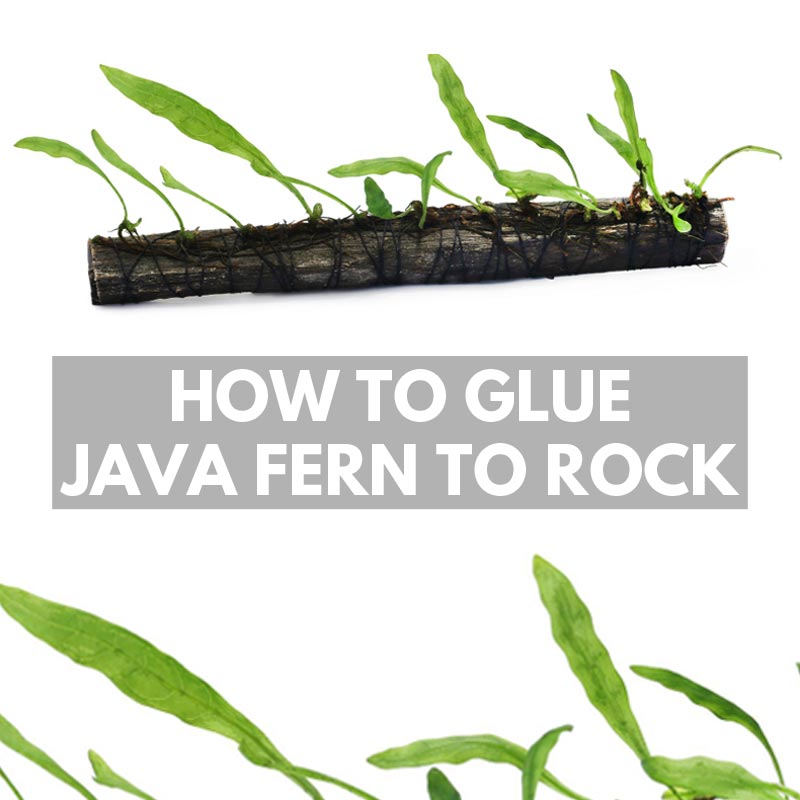
In this guide on how to glue java fern to rock, we share the two best types of glue for the job as well as the technique that will save you time and cause minimal stress to your fish.
How to Glue Java Fern to Rock
The best way to attach Java fern to rock is using a gel super glue. This is done easily and quite fast. In under 10 seconds, using a wetted surface, the super glue will bond the fern and rock together, and you can put it in the tank after just 30 minutes.
Adhering Java fern and other things to rock, driftwood, and props is a common task in fish tanks and aquariums.
Usually, glues cure from moisture in the air. The air is usually 5% moisture. So applying the glue to a clean and wetted surface dramatically accelerates the curing process. Gluing java fern to rock can even be done underwater if all your tank is already set up.
Which Glue Should you use for Java Fern to Rock?
Silicon and superglue are the most common glues used for gluing Java fern to rock in aquarium applications. You can even use super glue underwater if your setup calls for it.
Cyanoacrylate Glue (Super Glue)
Super Glue is the best glue to use to glue Java fern to rock in your aquarium and is safe to use in the aquarium environment. Any super glue will work. However, the more viscous gel type super glue is the best due to its no-drip behavior. It can even be used while the rock is in the tank, submerged underwater.
Bonding will happen in seconds, and super glue will dry in about a minute. So work fast. Like most self-curing glues, the activation for the glue to dry is exposure to moisture. Therefore the wet environment of Java fern and rocks is perfect for a fast bond of super glue.
RA AquaTech Aquarium Glue Clear is the superglue we recommend for fish tanks and it comes in 4 small tubes so you can dispose of them each time you glue a new java fern.
The gel superglue will not run along or down the sides of your rock. It stays in a nice convenient spot while you’re gluing. The extra thickness allows easier bonding to the Rhizome (root structure) of the Java fern.
Normal (non-gel) superglue can be very thin, which may make it harder to get the Java fern roots to get covered in enough glue. We recommend using only the gel form of super glue if you are gluing underwater. The gel-type super glue clumps together, making it less likely to float around in the water.
Super glue lines can sometimes turn white for a while when put under water, so no drip means so unsightly lines on your rocks. If this whiteness occurs, don’t worry, it disappears in a few days.
Normal “non-gel” superglue is also perfectly fine for the task regarding adhesion. Masking tape or similar things can be used to avoid unwanted overspills of glue or runs.

Silicon Adhesive
Silicon adhesive is a good choice for gluing Java fern to rock. However, there are some drawbacks and things to be aware of before using it.
Silicon adhesive works a bit differently from other glues. It does not melt the surfaces at the molecular level to create its bond; rather, it uses its ability to “grip” the surfaces together.
This is why silicon adhesive is a good choice to use for materials like rock and ceramics. Silicon adhesive forms a lasting bond and is waterproof. Hence we see it used in building glass aquariums and tanks.
Using silicon adhesive to glue Java fern to rock and anything else in a water-filled fish tank needs some caution.
It is best to use pure silicon adhesive designed for aquariums like the ASI clear and safe, which can be hard to find. There are millions of silicon variants and products on the market. Any silicon product with “extra capabilities” should be avoided and you should look for something that is safe for fish.
Extra capabilities are things like mold inhibitors, bacterial protection, anti-microbial properties, and so on, which are generally not safe for aquatic use. They CAN be safe once they are cured, but best to check the packaging details for this. Some products’ packaging stipulates “safe for aquariums”.
Some Advantages of Using Silicon to Glue Java Fern to Rock
- Easy to get a big root coverage due to its thick viscosity
- Versatility
- You likely already have some lying around
- Longer working time than super glue
Some Disadvantages of Using Silicon to Glue Java Fern to Rock
- Longer curing times
- Harder to use underwater than superglue
- Can be much messier than superglue
- More expensive than superglue

How to Prepare Java Fern and Rock Before Gluing
Preparing the Java fern and rock before gluing is quite simple. The rock surface needs to be clean and the Java fern should not have too much dirt on the roots.
There will naturally be some dirt on the Java fern, but as long as there is enough exposed root to contact the glue, it will be ok. Too much dirt and glue will stick to the dirt, not the roots, and the bond will not be as strong as you need.
The Java fern itself should ideally be kept wet at all times. So make sure it doesn’t dry out. You can cover it with a wet paper towel to help with this.
A dirty rock can be cleaned with an alcohol wipe or simply just a wet cloth. Wetting the surface of both the rock and the roots is a good idea as this will speed up the curing time of the super glue.
As always, with super glue, have some acetone (common in nail polish remover) nearby to get super glue off your skin easily.
How to Apply Glue to Java Fern and Rock
To apply super glue to Java fern and rock, first, clean the surfaces of the rock and wipe/shake off any excess dirt from the fern roots. Lightly wet the surfaces of the rock and the java fern roots. A spray bottle or wet cloth is all you need for this.
Apply some glue to the rock, appropriate to the size of the attaching fern roots. A bigger fern means more glue. A glue line the width of two toothpicks should be sufficient when using super glue. Silicon will need double that.
The wetted surfaces mean that the superglue will bond even faster than usual. In a few seconds, the bond will activate, and full curing will be in approximately 1 minute. So work fast.
Hold the Java fern at the plant base and apply pressure to the roots, so they stick to the glue. Keep the (light) pressure on for 5-10 seconds.
If using silicon glue, the curing time will be in the 5-30 minute range, so you may need to hold the fern roots in place with some masking tape.
How to Cure Java Fern and Rock Glue
Both silicon and super glue cure on their own using the moisture in the air. Both curing times are accelerated by extra moisture from the wet rock. Expect super glue to bond in seconds and cure in a few minutes, while silicon will bond and cure in the 5-30 minute range.
Conclusion
A gel-type super glue is the best glue to use when gluing Java fern to rock. Lightly wetting the rock and fern roots will make the super glue set even quicker than normal, and it is safe to use in aquariums.
We hope this step-by-step guide on how to glue java fern to rock has helped save you some time and has given you the tools to do it yourself.









